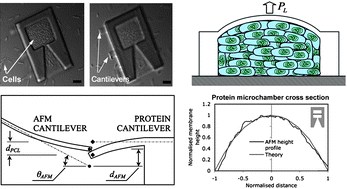Mechanically tunable multiphoton fabricated protein hydrogels investigated using atomic force microscopy†
Abstract
Recent work has demonstrated the feasibility of employing three dimensional (3D)

* Corresponding authors
a Center for Micro-Engineered Materials, University of New Mexico, Albuquerque, NM, USA
b Departments of Chemical and Nuclear Engineering and Molecular Genetics and Microbiology, University of New Mexico, NM, USA
c
Sandia National Laboratories, Advanced Materials Lab, NM, USA
E-mail:
bjkaehr@sandia.gov
Fax: +1 505-272-7336
Tel: +1 505-272-7665
Recent work has demonstrated the feasibility of employing three dimensional (3D)

 Please wait while we load your content...
Something went wrong. Try again?
Please wait while we load your content...
Something went wrong. Try again?
C. Y. Khripin, C. J. Brinker and B. Kaehr, Soft Matter, 2010, 6, 2842 DOI: 10.1039/C001193B
To request permission to reproduce material from this article, please go to the Copyright Clearance Center request page.
If you are an author contributing to an RSC publication, you do not need to request permission provided correct acknowledgement is given.
If you are the author of this article, you do not need to request permission to reproduce figures and diagrams provided correct acknowledgement is given. If you want to reproduce the whole article in a third-party publication (excluding your thesis/dissertation for which permission is not required) please go to the Copyright Clearance Center request page.
Read more about how to correctly acknowledge RSC content.
 Fetching data from CrossRef.
Fetching data from CrossRef.
This may take some time to load.
Loading related content
